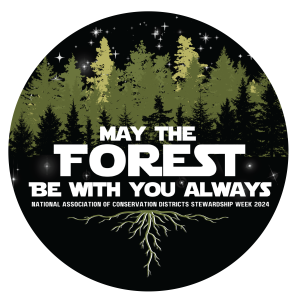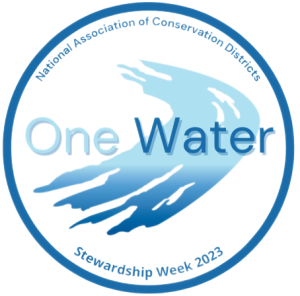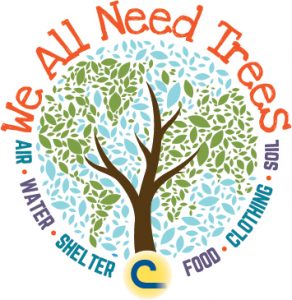Stewardship Program
Education is a critical element of the conservation effort at the local, state and national levels. Educating young people about the benefits of conservation helps to ensure the next generation will be wise stewards of America’s natural resources.
In 1955, the National Association of Conservation Districts began a national program to encourage Americans to focus on stewardship. Stewardship Week is officially celebrated from the last Sunday in April to the first Sunday in May. It is one of the world’s largest conservation-related observances.
The program relies on conservation districts sharing and promoting stewardship and conservation through field days, educational programming, and workshops to educate citizens about the need to care for our natural resources. Many district activities extend beyond the one-week observance to include an entire year of outreach. Stewardship Week helps to remind us all of the power each person has to conserve natural resources and improve the world. When everyone works together with their local conservation district, that power continuously grows.
For more information about NACD’s Stewardship Program, email stewardship[at]nacdnet.org.
Stewardship Themes
The Stewardship and Education team has developed a five-year rotation for stewardship topics – water, soil, habitat, forestry, and a topic of interest – and determines the theme each year. The 2024 Poster and Photo Contest theme is “May the Forest be with you, Always.”
The 2024 Stewardship week will be celebrated April 28-May 5, 2024 with the same theme.

May the forest be with you, always. The phrase carries a message of respect, appreciation, and harmony with nature, specifically highlighting the forest environment. It suggests that we should recognize the value of forests and the benefits they provide to us and for our future generations.
Forests are vital ecosystems that support diverse plant and animal life. They provide clean air and water, give us food, fuel, and other forest products, as well as help combat climate change by absorbing carbon dioxide. They offer recreational opportunities, serve as habitats for wildlife, and contribute to the overall well-being of the planet.
By saying “May the forest be with you, always,” it’s a way of expressing a desire for people to be mindful of the forests and to maintain a strong connection with nature. It encourages us to protect and preserve these important natural resources so that they can continue to thrive and benefit us in the long run.
Forestry is a cornerstone of natural resource conservation, promoting the responsible use of forests to meet human needs while safeguarding the ecological, social, and economic benefits these ecosystems provide. Through science-based management and conservation efforts, we can ensure that our forests remain healthy and resilient for future generations. Here’s a brief overview of how forestry contributes to natural resource conservation to assist in your local district Stewardship Week celebration outreach and education programs:
Biodiversity Preservation: Forests are incredibly diverse ecosystems, home to a wide range of plant and animal species. Forestry practices focus on maintaining this biodiversity by protecting and enhancing the habitat for various flora and fauna. Careful management helps prevent habitat destruction and ensures the survival of many species.
Carbon Sequestration: Forests act as natural carbon sinks, absorbing carbon dioxide (CO2) from the atmosphere during photosynthesis. Sustainable forestry practices help maintain and expand forested areas, which contributes to carbon sequestration, mitigating climate change by reducing CO2 levels.
Water Quality and Quantity: Forests play a critical role in regulating water cycles. They help filter and purify water, preventing soil erosion and maintaining water quality in rivers and streams. Forested watersheds also help regulate water flow, reducing the risk of flooding and ensuring a steady supply of clean water for communities.
Timber Production: Forestry is also about responsible timber production. Sustainable logging practices ensure that timber resources are harvested without depleting forests. These practices include selective logging, reforestation, and maintaining healthy forest ecosystems.
Recreation and Education: Forests provide recreational opportunities for hiking, camping, and wildlife observation, fostering a connection between people and nature. Additionally, they serve as outdoor classrooms for environmental education, raising awareness about conservation and the importance of forests.
Wildfire Management: Proper forestry practices can reduce the risk of catastrophic wildfires. Thinning dense forests, creating firebreaks, and prescribed burns are strategies employed to manage the fire-prone areas effectively, protecting both ecosystems and communities.
Economic Sustainability: Sustainable forestry management is crucial for the long-term economic well-being of communities dependent on timber and forest-related industries. Balancing economic interests with conservation ensures the continued availability of forest resources.
Incorporating forestry into climate-smart conservation strategies is vital, aligning with global climate change efforts. Forests serve as crucial carbon sinks, absorbing and storing carbon to reduce greenhouse gas emissions. Sustainable forestry practices are evolving to combat climate challenges like rising temperatures and pests.
NACD recognizes the importance of these efforts and applauds local conservation districts for their support in adaptive forest management. They help reduce greenhouse gas emissions, bridging local actions with global impact.
The 2024 stewardship theme, “May the Forest be with you, Always,” offers an opportunity to introduce climate-smart initiatives to communities through educational workshops, student outreach, and community events. Together, we can preserve ecosystems, mitigate climate change, and build a more sustainable future.
Poster Contest: The annual NACD Poster Contest provides students from kindergarten through 12th grade the chance to have their art displayed as part of a national conservation outreach initiative. Each year, the winning posters reflect NACD’s annual Stewardship theme and highlight the work of conservation districts and their state conservation associations, auxiliaries, and agencies to protect and enhance natural resources. The contest starts at the district level; winners advance to the state level, and then to the national level, where they receive recognition at NACD’s annual meeting.
All entries at the local and state-level contest must be submitted by the due dates set by your local conservation district. Posters for the national contest will only be accepted from state poster contest organizers.
Find contact information for your local conservation district on NACD’s Conservation District Directory.
The poster contest is open to public, private, and home-schooled students. All poster submissions must be sponsored by a local conservation district.
Click on the logos below to view and download resources from previous years’ stewardship themes.














